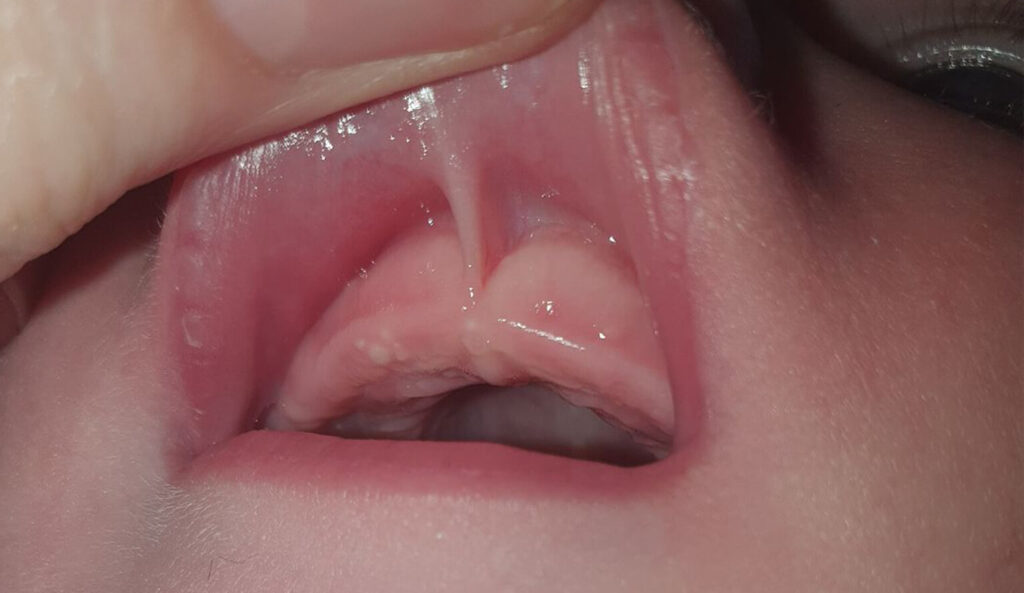Tongue Tie
Uncompromised quality
We use quintessential quality materials and stringent sterilisation protocols to ensure that you don't have any medical or dental complications in future.
Anxiety Free Dentistry
Experience the treatment process in a pleasant atmosphere from handpicked expert clinicians, with unparalleled clinical etiquette, to ensure exemplary health care.
Best in class outcomes
We strive our best, so that we can keep our promise of delivering the individualized smiles that we have reimagined for you with latest techniques and technologies.
Tongue Tie: What Parents Need to Know for Their Little Ones


Tongue tie is a condition that affects many people, from infants to adults, and it can have a significant impact on their ability to speak, eat, and even breathe properly. At its core, tongue tie is a condition where the frenulum, a small piece of tissue that connects the tongue to the floor of the mouth, is too short or too tight. This can limit the movement of the tongue and make it difficult to perform certain actions.
For infants, tongue tie can make it difficult to breastfeed or bottle-feed properly, leading to issues with weight gain and nutrition. In children, it can lead to speech difficulties, trouble with chewing and swallowing, and even dental problems. In adults, tongue tie can cause issues with snoring, and sleep apnea, and even affect the ability to play certain wind instruments.
While tongue tie can be a frustrating and sometimes even debilitating condition, the good news is that there are many effective treatments available. These range from simple stretches and exercises to more advanced procedures like frenotomy or frenuloplasty.
With the right care and attention, those with tongue ties can unlock their full potential and enjoy improved function, health, and well-being. So, whether you’re a parent concerned about your child’s development or an adult struggling with tongue-tie yourself, there are plenty of options available to help you overcome this condition and thrive.
- Genetics: There may be a hereditary component to tongue tie, as it tends to run in families.
- Abnormal development: During fetal development, the tongue and the frenulum form separately and fuse together. If this process is disrupted or incomplete, it may result in tongue tie.
- Excessive tissue growth: In some cases, the frenulum may simply be larger or thicker than usual, making it harder for the tongue to move freely.
- Certain medical conditions: Some medical conditions, such as Ehlers-Danlos syndrome or Down syndrome, may increase the risk of tongue tie.
- Environmental factors: Some environmental factors, such as exposure to toxins or certain medications, may contribute to the development of tongue ties.
- Difficulty breastfeeding: Infants with tongue ties may have difficulty latching onto the breast, leading to poor weight gain, frustration during feeding, and nipple pain for the mother.
- Speech difficulties: Tongue tie can make it difficult to produce certain sounds, such as “l,” “r,” “s,” and “th,” leading to speech difficulties and sometimes a lisp.
- Eating and swallowing difficulties: Tongue tie can make it difficult to chew and swallow food, leading to choking or gagging, or difficulty advancing to solid foods.
- Dental problems: Tongue tie can lead to dental issues such as tooth decay, gingivitis, or gum disease, as well as an increased risk of dental crowding.
- Mouth breathing: In severe cases, tongue tie can cause a person to breathe primarily through their mouth, leading to dry mouth, bad breath, and other respiratory issues.
- Reduced tongue mobility: A tongue tie can limit the movement of the tongue, making it difficult to stick out the tongue, touch the roof of the mouth, or move it side to side.
- Sleep problems: Tongue tie can cause snoring, sleep apnea, and other sleep disturbances, leading to daytime fatigue and other health issues.
- Anterior tongue tie: This is the most common type of tongue tie, in which the frenulum is attached near the tip of the tongue. This can limit the tongue’s ability to move freely, leading to issues with breastfeeding, speech, and other functions.
- Posterior tongue tie: In this type of tongue tie, the frenulum is attached farther back on the tongue, near the base of the tongue. This can be harder to diagnose than anterior tongue tie, as it may not be visible during a routine exam.
- Submucosal tongue tie: In this type of tongue tie, the frenulum is located beneath the surface of the tongue mucosa, making it harder to identify without a more detailed examination.
- Partial tongue tie: This type of tongue tie refers to a frenulum shorter than usual but not fully restricting the tongue’s movement. It may still cause issues with feeding, speech, or other functions.
- Complete tongue tie: This is the most severe form of tongue tie, in which the frenulum fully restricts the movement of the tongue, making it difficult or impossible to perform certain functions.
- Frenotomy or frenectomy: This is a minor surgical procedure in which the frenulum is snipped or cut, allowing the tongue to move more freely. This can be done with a scalpel, scissors, or a laser, and is often a quick and relatively painless procedure.
- Exercises: After a frenotomy or frenectomy, the individual may be given exercises to do to help strengthen and stretch the tongue and surrounding muscles. This can help improve feeding, speech, and other functions.
- Speech therapy: If the individual is experiencing speech difficulties, speech therapy may be recommended to help them learn to produce certain sounds more effectively.
- Feeding support: For infants with tongue ties, breastfeeding support, and education may be provided to help them learn to latch more effectively and reduce pain for the mother.
- Orthodontic treatment: In some cases, orthodontic treatment such as braces or other devices may be recommended to help correct any dental issues caused by tongue tying.
- Myofunctional therapy: This type of therapy focuses on strengthening the tongue and surrounding muscles to improve feeding, speech, and other functions.
- Evaluation and diagnosis: The first step in treating tongue tie is to undergo an evaluation with a qualified healthcare provider, such as a pediatrician, ENT specialist, or lactation consultant. The provider will examine the tongue and frenulum and may ask about symptoms and medical history to make a diagnosis.
- Treatment plan: Once a diagnosis is made, the healthcare provider will work with the individual and their family to develop a treatment plan based on their specific needs. This may include a recommendation for frenotomy or frenectomy, exercises, speech therapy, feeding support, or other interventions.
- Frenotomy or frenectomy: If the healthcare provider recommends a frenotomy or frenectomy, the procedure may be performed in the office or clinic using a scalpel, scissors, or laser. The area will be numbed with a local anesthetic, and the procedure itself typically takes only a few minutes. After the procedure, the individual may be given exercises to do to help promote healing and improve tongue mobility.
- Follow-up care: After the procedure, the healthcare provider will provide instructions for follow-up care, which may include exercises, feeding support, and/or speech therapy. The provider may also schedule a follow-up visit to check on the individual’s progress and make any necessary adjustments to the treatment plan.
- Continued monitoring: It’s important to continue monitoring the individual’s progress over time to ensure that the treatment is effective and that any lingering symptoms are addressed. In some cases, additional interventions may be recommended if symptoms persist or new issues arise.
- Improved feeding: For infants and young children, treating tongue ties can improve breastfeeding and bottle feeding, allowing them to latch and feed more. This can reduce pain and discomfort for both the infant and the mother, and improve overall nutrition and growth.
- Improved speech: Treating tongue ties can also improve speech in individuals of all ages. By allowing the tongue to move more freely, individuals may be better able to produce certain sounds and articulate words more effectively, improving communication and overall quality of life.
- Reduced dental issues: In some cases, tongue tie can cause dental issues such as crowded teeth, a high palate, or a gap between the front teeth. Treating tongue ties can help to prevent or correct these issues, improving oral health and reducing the need for orthodontic treatment.
- Improved sleep: For some individuals, tongue tie can cause breathing issues during sleep, leading to snoring or sleep apnea. Treating tongue ties can help to improve airflow and reduce these issues, leading to better sleep and overall health.
- Improved quality of life: By improving feeding, speech, dental health, and sleep, treating tongue ties can have a positive impact on the overall quality of life for individuals of all ages. It can reduce pain, discomfort, and frustration, and help individuals to better participate in social, educational, and professional activities.
- Maintain good oral hygiene: Proper oral hygiene is crucial to prevent infection and promote healing. Brush your teeth and tongue gently twice a day, and rinse your mouth with warm salt water after meals to reduce inflammation and promote healing.
- Avoid spicy or acidic foods: Spicy and acidic foods can cause discomfort and irritation to the tongue, which can slow down the healing process. Stick to soft, bland foods for a few days after the treatment.
- Stay hydrated: Drink plenty of fluids, especially water, to keep your mouth and body hydrated. This can also help reduce inflammation and prevent infection.
- Perform tongue exercises: Your healthcare provider may recommend certain exercises to improve tongue mobility and prevent scar tissue formation. Follow their instructions and perform the exercises regularly.
- Manage pain and discomfort: It’s normal to experience some pain and discomfort after treatment. You can use over-the-counter pain relievers to manage the pain.
- Attend follow-up appointments: Follow-up appointments with your healthcare provider are crucial to monitor the healing process and ensure that the tongue tie is fully resolved.
- Breastfeeding difficulties: Infants with tongue ties may have difficulty latching onto the breast, which can lead to poor feeding and weight gain issues.
- Speech difficulties: Tongue tie can affect a person’s ability to pronounce certain sounds, which can lead to speech difficulties and communication problems.
- Dental issues: Tongue tie can lead to a gap between the front teeth, which can cause dental problems and affect the appearance of the smile.
- Eating difficulties: Tongue tie can make it difficult to move food around the mouth and swallow, which can lead to choking or aspiration.
- Sleep apnea: In some cases, tongue tie can contribute to obstructive sleep apnea, a condition where breathing stops and starts during sleep.
- Jaw and neck pain: Tongue tie can cause tension and pain in the jaw and neck, which can affect overall comfort and quality of life.
- Difficulty sticking out your tongue past your lower front teeth.
- Difficulty lifting the tongue to the roof of the mouth or moving it from side to side.
- A heart-shaped or notched appearance of the tongue tip when extended.
- Speech difficulties, such as trouble with certain sounds or pronouncing words correctly.
- Difficulty with oral hygiene, such as scraping food off teeth or cleaning the tongue properly.
- A noticeable tight or short band of tissue under the tongue can limit tongue movement.
There is some evidence to suggest that tongue ties may have an effect on posture. The tongue is an important muscle that helps to support the upper body and head, and it plays a crucial role in proper head and neck posture.
When the tongue is restricted due to tongue tie, it may lead to compensatory movements in the head and neck, which can affect overall posture.
Studies have shown that individuals with tongue ties may have a forward head posture, which can cause strain on the neck and upper back muscles. This may also lead to changes in the alignment of the spine, resulting in poor posture.
In addition, tongue ties can affect the muscles of the mouth and face, which can impact overall facial structure and alignment. This may lead to changes in jaw alignment and bite, which can also affect posture.
It’s important to note that the effects of tongue tie on posture can vary depending on the severity of the condition and individual factors. If you are experiencing symptoms related to tongue tie or poor posture, it’s recommended to seek the advice of a healthcare professional with expertise in tongue tie assessment and management, as well as postural evaluation and treatment.
We at Kigo Dental are committed to providing you with the best dental care available, and we do so with a smile.
Our entire staff, from receptionists to dental hygienists and assistants, is committed to providing you with the best quality dental care possible.
From the time you walk through the door and every time you revisit, you will experience this firsthand.
Kigo Dental has a team of experienced and skilled Orthodontists and other specialized dentists who specialize in providing high-quality dental care and treatments, utilizing the latest technologies and techniques to ensure the best patient outcomes.
FAQ's
Tongue tie, or ankyloglossia, is a condition where the tissue connecting the tongue to the bottom of the mouth is shorter or tighter than usual, limiting the movement of the tongue.
Tongue tie is usually a congenital condition, meaning it is present at birth. In some cases, it may be hereditary or associated with certain genetic conditions.
Symptoms of tongue tie can include difficulty with breastfeeding, speech difficulties, dental issues, eating difficulties, sleep apnea, and jaw and neck pain.
Yes, tongue tie can be diagnosed by a healthcare provider through a physical examination. In some cases, additional testing or evaluation may be needed to determine the severity of the condition and the best course of treatment.
Not all cases of tongue tie require treatment, as some people can adapt to the condition and live without any issues. However, treatment may be recommended if a person is experiencing difficulty with breastfeeding, speech difficulties, dental issues, eating difficulties, sleep apnea, or jaw and neck pain.
Tongue tie can be treated through a simple procedure called frenotomy or frenuloplasty, which involves cutting the tissue that connects the tongue to the bottom of the mouth to allow for better tongue movement.
The treatment for tongue tie is usually quick and straightforward and is not typically painful. A local anesthetic may be used to numb the area before the procedure to reduce discomfort.
Tongue tie treatment can be performed by a variety of healthcare providers, including pediatricians, dentists, oral surgeons, and ear, nose, and throat (ENT) specialists. It’s important to consult with a healthcare provider who has experience in treating tongue tie and can recommend appropriate treatment options.
There is no surefire way to prevent tongue tie from occurring, as it is typically a congenital condition. However, early detection and treatment can help prevent complications and improve the overall quality of life.










Wisdom Teeth: Understanding the What, Why, and When
Wisdom teeth, also known as third molars, are often a source of concern for many people. They can lead to various dental issues, including wisdom










Smile Makeover with Dental Crowns: Types, Overview & cost
A smile is one of the most attractive features a person can have. It can boost your confidence, make you more approachable, and even improve










Beyond the smile: Exploring the crucial role of teeth in your overall health
Teeth are often linked to the ability to smile, eat, and express oneself. However, teeth serve many other vital purposes as well. Your teeth have










The Silent Threat: How Gum Diseases Lead to Tooth Loss
Having strong teeth and gums is a reflection of your entire well-being, not simply your appearance. Despite this, many people don’t give their gums the










The Importance of Orthodontists in Clear Aligner Treatment: Avoiding Problems and Ensuring Successful Outcomes
More and more individuals are seeking out clear aligner treatment as a way to improve their smile in a way that is both subtle and










Understanding Abnormal Dental Habits in Children and the Importance of Control
As parents and caregivers, we play a pivotal role in shaping our children’s habits and behaviors, especially when it comes to their oral health. However,










Wisdom Teeth: Understanding the What, Why, and When
Wisdom teeth, also known as third molars, are often a source of concern for many people. They can lead to various dental issues, including wisdom










Smile Makeover with Dental Crowns: Types, Overview & cost
A smile is one of the most attractive features a person can have. It can boost your confidence, make you more approachable, and even improve










Beyond the smile: Exploring the crucial role of teeth in your overall health
Teeth are often linked to the ability to smile, eat, and express oneself. However, teeth serve many other vital purposes as well. Your teeth have










The Silent Threat: How Gum Diseases Lead to Tooth Loss
Having strong teeth and gums is a reflection of your entire well-being, not simply your appearance. Despite this, many people don’t give their gums the










The Importance of Orthodontists in Clear Aligner Treatment: Avoiding Problems and Ensuring Successful Outcomes
More and more individuals are seeking out clear aligner treatment as a way to improve their smile in a way that is both subtle and










Understanding Abnormal Dental Habits in Children and the Importance of Control
As parents and caregivers, we play a pivotal role in shaping our children’s habits and behaviors, especially when it comes to their oral health. However,










Wisdom Teeth: Understanding the What, Why, and When
Wisdom teeth, also known as third molars, are often a source of concern for many people. They can lead to various dental issues, including wisdom










Smile Makeover with Dental Crowns: Types, Overview & cost
A smile is one of the most attractive features a person can have. It can boost your confidence, make you more approachable, and even improve










Beyond the smile: Exploring the crucial role of teeth in your overall health
Teeth are often linked to the ability to smile, eat, and express oneself. However, teeth serve many other vital purposes as well. Your teeth have










The Silent Threat: How Gum Diseases Lead to Tooth Loss
Having strong teeth and gums is a reflection of your entire well-being, not simply your appearance. Despite this, many people don’t give their gums the










The Importance of Orthodontists in Clear Aligner Treatment: Avoiding Problems and Ensuring Successful Outcomes
More and more individuals are seeking out clear aligner treatment as a way to improve their smile in a way that is both subtle and










Understanding Abnormal Dental Habits in Children and the Importance of Control
As parents and caregivers, we play a pivotal role in shaping our children’s habits and behaviors, especially when it comes to their oral health. However,










Wisdom Teeth: Understanding the What, Why, and When
Wisdom teeth, also known as third molars, are often a source of concern for many people. They can lead to various dental issues, including wisdom










Smile Makeover with Dental Crowns: Types, Overview & cost
A smile is one of the most attractive features a person can have. It can boost your confidence, make you more approachable, and even improve










Beyond the smile: Exploring the crucial role of teeth in your overall health
Teeth are often linked to the ability to smile, eat, and express oneself. However, teeth serve many other vital purposes as well. Your teeth have










The Silent Threat: How Gum Diseases Lead to Tooth Loss
Having strong teeth and gums is a reflection of your entire well-being, not simply your appearance. Despite this, many people don’t give their gums the










The Importance of Orthodontists in Clear Aligner Treatment: Avoiding Problems and Ensuring Successful Outcomes
More and more individuals are seeking out clear aligner treatment as a way to improve their smile in a way that is both subtle and










Understanding Abnormal Dental Habits in Children and the Importance of Control
As parents and caregivers, we play a pivotal role in shaping our children’s habits and behaviors, especially when it comes to their oral health. However,
The Lip Tie Epidemic: What Every Parent Needs to Know


There are different types of lip ties, and they can vary in severity. Here are the most common types of lip ties:
Class 1: This is the mildest form of lip tie, where the frenulum is attached to the gum line, but it does not extend beyond the edge of the gum line. This type of lip tie may not cause any symptoms or require treatment.
Class 2: In this type of lip tie, the frenulum extends beyond the edge of the gum line and may reach the tip of the papilla (the triangular gum tissue between the two upper front teeth). This type of lip tie can cause some mild to moderate symptoms, such as breastfeeding difficulties or speech issues, and may require treatment.
Class 3: This is the most severe form of lip tie, where the frenulum is attached deep in the gum tissue, and may even reach the bone. This type of lip tie can cause significant symptoms, such as difficulty breastfeeding, speech difficulties, and even dental problems such as gum recession. Treatment is usually recommended for Class 3 lip ties.
The treatment of lip tie depends on the severity of the condition, as well as the symptoms it is causing. Here are some of the most common treatments for lip tie:
- Frenotomy: This is a simple procedure that involves cutting the frenulum to release the lip tie. The procedure can usually be performed in a doctor’s office, and it takes only a few minutes. Frenotomy is typically recommended for Class 2 or 3 lip ties, especially if they are causing feeding or speech difficulties.
- Frenuloplasty: This is a more complex surgical procedure that may be recommended for severe cases of lip tie, where the frenulum is attached deep in the gum tissue. Frenuloplasty involves creating a new attachment for the frenulum, which allows for greater lip movement. This procedure may require general anesthesia and a longer recovery time than a frenotomy.
- Stretching exercises: In some cases, lip ties can be treated with stretching exercises that help to loosen the frenulum and improve lip movement. This approach may be recommended for mild cases of lip tie, or as a way to prepare for frenotomy or frenuloplasty.
- Preparation: The healthcare professional will first examine the lip tie to determine the best approach for the procedure. In some cases, a topical anesthetic may be applied to the area to minimize discomfort.
- Frenotomy: The healthcare professional will then use a small pair of scissors or a laser to cut the frenulum and release the lip tie. The procedure only takes a few minutes, and it is usually performed with the baby or child sitting on their caregiver’s lap.
- Post-procedure care: After the procedure, the healthcare professional may recommend some stretching exercises to help prevent the frenulum from reattaching. It’s also important to keep the area clean and to avoid any hard or crunchy foods for a few days to allow the area to heal.
- Manage pain and discomfort: Depending on the procedure and the individual’s medical history, the healthcare provider may recommend over-the-counter pain medication, such as acetaminophen or ibuprofen, to manage any pain or discomfort after the procedure. They may also recommend using a cold compress on the affected area to reduce swelling and discomfort.
- Practice good oral hygiene: After the procedure, it’s important to maintain good oral hygiene to help prevent infection and promote healing. This may include gently brushing the affected area with a soft-bristled toothbrush and rinsing with salt water or an antiseptic mouthwash.
- Avoid certain foods and drinks: Depending on the procedure, the healthcare provider may recommend avoiding certain foods and drinks that can irritate the affected area or interfere with healing, such as hot or spicy foods, acidic foods and drinks, and alcohol.
- Follow feeding instructions: If the procedure was performed on a baby who is breastfeeding, the healthcare provider may recommend feeding the baby immediately after the procedure to help soothe them and encourage healing. They may also provide specific feeding instructions or techniques to help ensure a successful breastfeeding experience.
- Attend follow-up appointments: Depending on the procedure and the individual’s medical history, the healthcare provider may schedule one or more follow-up appointments to monitor healing and ensure a successful outcome. It’s important to attend these appointments and follow any additional instructions provided by the provider.
- Difficulty breastfeeding: If you are a newborn or infant, difficulty latching or maintaining suction during breastfeeding can be a sign of lip tie. This is because a lip tie can limit the range of motion of the upper lip, making it difficult to create a good seal around the breast.
- Gum recession or spacing between teeth: In children and adults, a lip tie can cause a gap or space between the front teeth, as well as gum recession or an uneven gum line.
- Difficulty with oral hygiene: A lip tie can make it difficult to properly clean the teeth and gums, which can lead to an increased risk of tooth decay and gum disease.
- Speech difficulties: In some cases, a lip tie can affect speech by making it difficult to properly enunciate certain sounds, such as “b,” “p,” and “m.”
- Lip discomfort or pain: A lip tie can cause discomfort or pain in the upper lip, especially during activities such as smiling, kissing, or playing certain musical instruments.
- Infants: If a newborn or infant is having difficulty breastfeeding due to a lip tie, treatment may be recommended to improve feeding outcomes and prevent complications such as inadequate weight gain.
- Children: In children, a lip tie can cause dental issues such as spacing between the front teeth, gum recession, or an uneven gum line. Treatment may be recommended to prevent further dental problems and improve oral health.
- Adults: In adults, a lip tie can cause discomfort or pain in the upper lip, affect speech, and make it difficult to properly clean the teeth and gums. Treatment may be recommended to alleviate these symptoms and prevent further complications.
- Difficulty breastfeeding: In newborns and infants, untreated lip tie can make it difficult to properly latch and maintain suction during breastfeeding. This can lead to poor weight gain, malnutrition, and other health issues.
- Dental problems: In children and adults, untreated lip ties can cause dental problems such as spacing between the front teeth, gum recession, and an uneven gum line. This can increase the risk of tooth decay, gum disease, and other oral health issues.
- Speech difficulties: In some cases, untreated lip ties can affect speech development and cause difficulty enunciating certain sounds, such as “b,” “p,” and “m.”
- Discomfort and pain: Untreated lip ties can cause discomfort or pain in the upper lip, especially during activities such as smiling, kissing, or playing certain musical instruments.
- Psychological and social issues: In some cases, untreated lip ties can affect self-esteem and cause social anxiety or self-consciousness, especially in situations where the lip is visible.
We at Kigo Dental are committed to providing you with the best dental care available, and we do so with a smile.
Our entire staff, from receptionists to dental hygienists and assistants, is committed to providing you with the best quality dental care possible.
From the time you walk through the door and every time you revisit, you will experience this firsthand.
Kigo Dental has a team of experienced and skilled Orthodontists and other specialized dentists who specialize in providing high-quality dental care and treatments, utilizing the latest technologies and techniques to ensure the best patient outcomes.
FAQ's
Tongue tie, or ankyloglossia, is a condition where the tissue connecting the tongue to the bottom of the mouth is shorter or tighter than usual, limiting the movement of the tongue.
Tongue tie is usually a congenital condition, meaning it is present at birth. In some cases, it may be hereditary or associated with certain genetic conditions.
Symptoms of tongue tie can include difficulty with breastfeeding, speech difficulties, dental issues, eating difficulties, sleep apnea, and jaw and neck pain.
Yes, tongue tie can be diagnosed by a healthcare provider through a physical examination. In some cases, additional testing or evaluation may be needed to determine the severity of the condition and the best course of treatment.
Not all cases of tongue tie require treatment, as some people can adapt to the condition and live without any issues. However, treatment may be recommended if a person is experiencing difficulty with breastfeeding, speech difficulties, dental issues, eating difficulties, sleep apnea, or jaw and neck pain.
Tongue tie can be treated through a simple procedure called frenotomy or frenuloplasty, which involves cutting the tissue that connects the tongue to the bottom of the mouth to allow for better tongue movement.
The treatment for tongue tie is usually quick and straightforward and is not typically painful. A local anesthetic may be used to numb the area before the procedure to reduce discomfort.
Tongue tie treatment can be performed by a variety of healthcare providers, including pediatricians, dentists, oral surgeons, and ear, nose, and throat (ENT) specialists. It’s important to consult with a healthcare provider who has experience in treating tongue tie and can recommend appropriate treatment options.
There is no surefire way to prevent tongue tie from occurring, as it is typically a congenital condition. However, early detection and treatment can help prevent complications and improve the overall quality of life.










Wisdom Teeth: Understanding the What, Why, and When
Wisdom teeth, also known as third molars, are often a source of concern for many people. They can lead to various dental issues, including wisdom










Smile Makeover with Dental Crowns: Types, Overview & cost
A smile is one of the most attractive features a person can have. It can boost your confidence, make you more approachable, and even improve










Beyond the smile: Exploring the crucial role of teeth in your overall health
Teeth are often linked to the ability to smile, eat, and express oneself. However, teeth serve many other vital purposes as well. Your teeth have










The Silent Threat: How Gum Diseases Lead to Tooth Loss
Having strong teeth and gums is a reflection of your entire well-being, not simply your appearance. Despite this, many people don’t give their gums the










The Importance of Orthodontists in Clear Aligner Treatment: Avoiding Problems and Ensuring Successful Outcomes
More and more individuals are seeking out clear aligner treatment as a way to improve their smile in a way that is both subtle and










Understanding Abnormal Dental Habits in Children and the Importance of Control
As parents and caregivers, we play a pivotal role in shaping our children’s habits and behaviors, especially when it comes to their oral health. However,










Wisdom Teeth: Understanding the What, Why, and When
Wisdom teeth, also known as third molars, are often a source of concern for many people. They can lead to various dental issues, including wisdom










Smile Makeover with Dental Crowns: Types, Overview & cost
A smile is one of the most attractive features a person can have. It can boost your confidence, make you more approachable, and even improve










Beyond the smile: Exploring the crucial role of teeth in your overall health
Teeth are often linked to the ability to smile, eat, and express oneself. However, teeth serve many other vital purposes as well. Your teeth have










The Silent Threat: How Gum Diseases Lead to Tooth Loss
Having strong teeth and gums is a reflection of your entire well-being, not simply your appearance. Despite this, many people don’t give their gums the










The Importance of Orthodontists in Clear Aligner Treatment: Avoiding Problems and Ensuring Successful Outcomes
More and more individuals are seeking out clear aligner treatment as a way to improve their smile in a way that is both subtle and










Understanding Abnormal Dental Habits in Children and the Importance of Control
As parents and caregivers, we play a pivotal role in shaping our children’s habits and behaviors, especially when it comes to their oral health. However,










Wisdom Teeth: Understanding the What, Why, and When
Wisdom teeth, also known as third molars, are often a source of concern for many people. They can lead to various dental issues, including wisdom










Smile Makeover with Dental Crowns: Types, Overview & cost
A smile is one of the most attractive features a person can have. It can boost your confidence, make you more approachable, and even improve










Beyond the smile: Exploring the crucial role of teeth in your overall health
Teeth are often linked to the ability to smile, eat, and express oneself. However, teeth serve many other vital purposes as well. Your teeth have










The Silent Threat: How Gum Diseases Lead to Tooth Loss
Having strong teeth and gums is a reflection of your entire well-being, not simply your appearance. Despite this, many people don’t give their gums the










The Importance of Orthodontists in Clear Aligner Treatment: Avoiding Problems and Ensuring Successful Outcomes
More and more individuals are seeking out clear aligner treatment as a way to improve their smile in a way that is both subtle and










Understanding Abnormal Dental Habits in Children and the Importance of Control
As parents and caregivers, we play a pivotal role in shaping our children’s habits and behaviors, especially when it comes to their oral health. However,










Wisdom Teeth: Understanding the What, Why, and When
Wisdom teeth, also known as third molars, are often a source of concern for many people. They can lead to various dental issues, including wisdom










Smile Makeover with Dental Crowns: Types, Overview & cost
A smile is one of the most attractive features a person can have. It can boost your confidence, make you more approachable, and even improve










Beyond the smile: Exploring the crucial role of teeth in your overall health
Teeth are often linked to the ability to smile, eat, and express oneself. However, teeth serve many other vital purposes as well. Your teeth have










The Silent Threat: How Gum Diseases Lead to Tooth Loss
Having strong teeth and gums is a reflection of your entire well-being, not simply your appearance. Despite this, many people don’t give their gums the










The Importance of Orthodontists in Clear Aligner Treatment: Avoiding Problems and Ensuring Successful Outcomes
More and more individuals are seeking out clear aligner treatment as a way to improve their smile in a way that is both subtle and










Understanding Abnormal Dental Habits in Children and the Importance of Control
As parents and caregivers, we play a pivotal role in shaping our children’s habits and behaviors, especially when it comes to their oral health. However,
FAQ's
Lip tie is a condition where the frenulum, a small piece of tissue that connects the upper lip to the gums, is too thick, tight, or short, causing limited movement of the upper lip.
Lip tie is a common condition, with estimates suggesting that up to 10% of newborns may have some degree of lip tie.
Yes, in newborns and infants, lip tie can make it difficult to properly latch and maintain suction during breastfeeding, leading to poor weight gain, malnutrition, and other health issues.
Symptoms of lip tie may include difficulty breastfeeding, dental issues, speech difficulties, discomfort or pain in the upper lip, and an uneven gum line.
Lip ties may be treated with a frenotomy or frenuloplasty, which involves releasing the frenulum to improve the movement of the upper lip.
The frenotomy or frenuloplasty procedure is typically a quick and simple outpatient procedure that is well-tolerated by patients of all ages.
Untreated lip ties can cause difficulty breastfeeding, dental problems, speech difficulties, discomfort or pain in the upper lip, and psychological and social issues.
In rare cases, the frenulum may reattach and cause a recurrence of lip tie. However, this can often be resolved with additional treatment.
There is no known way to prevent lip tie, as it is often a congenital condition. However, early diagnosis and treatment can prevent potential complications.
The frenotomy or frenuloplasty procedure usually takes only a few minutes to complete. However, you may need to allow extra time for preparation and recovery.
In most cases, you can resume breastfeeding immediately after lip tie treatment. Your healthcare provider can provide specific instructions and guidance based on your individual situation.
Lip tie treatment is not expected to have a negative impact on speech development. In fact, releasing the tight frenulum can improve the range of motion in the upper lip and may have a positive effect on speech.
The risks associated with lip tie treatment are generally low. However, as with any medical procedure, there is a small risk of bleeding, infection, and other complications.










Wisdom Teeth: Understanding the What, Why, and When
Wisdom teeth, also known as third molars, are often a source of concern for many people. They can lead to various dental issues, including wisdom










Smile Makeover with Dental Crowns: Types, Overview & cost
A smile is one of the most attractive features a person can have. It can boost your confidence, make you more approachable, and even improve










Beyond the smile: Exploring the crucial role of teeth in your overall health
Teeth are often linked to the ability to smile, eat, and express oneself. However, teeth serve many other vital purposes as well. Your teeth have










The Silent Threat: How Gum Diseases Lead to Tooth Loss
Having strong teeth and gums is a reflection of your entire well-being, not simply your appearance. Despite this, many people don’t give their gums the










The Importance of Orthodontists in Clear Aligner Treatment: Avoiding Problems and Ensuring Successful Outcomes
More and more individuals are seeking out clear aligner treatment as a way to improve their smile in a way that is both subtle and










Understanding Abnormal Dental Habits in Children and the Importance of Control
As parents and caregivers, we play a pivotal role in shaping our children’s habits and behaviors, especially when it comes to their oral health. However,
LET'S TALK
Book your Appointment
Appointment Timings: Mon-sat: 10:00 am- 8:00 pm |
Sun: 10:00 am - 1:00 pm
Contact
We would love to be a part of your Smile Reimagining Journey...
- 2nd Floor, QUBE, Plot No: 3-64/A, Kavuri Hills Rd, Jubilee Hills, Hyderabad, Telangana 500033
-
+91 9998884398
- kigodental@gmail.com
-
Mon - Sat: 10:00 am - 8:30 pm
Sun: 10:00 am - 1:00 pm